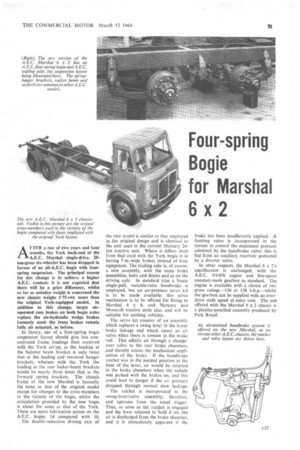Four-spring Bogie for Marshal
Page 73

If you've noticed an error in this article please click here to report it so we can fix it.
6x2 AFTER a run of two years and four months, the York back-end of the A.E.C. Marshal single-drive, 20ton-gross six-wheeler has been dropped in favour of an all-A.E.C. bogie with fourspring suspension. The principal reason for this change is to achieve a higher A.E.C. content: it is not expected that there will be a price difference, whilst so far as unladen weight is concerned the new chassis weighs 1.75 cwt. more than the original York-equipped model. In addition to this change, larger airoperated cam brakes on both bogie axles replace the air-hydraulic wedge brakes formerly used: the front brakes remain fully air actuated, as before.
In theory, use of a four-spring bogie suspension layout should give less concentrated frame loadings than occurred with the York set-PP, as the loading at the balance beam bracket is only twice that at the leading and rearmost hanger brackets, whereas with the York the loading at the rear locker-beam brackets would be nearly three times that at the forward spring brackets. The chassis frame of the new Marshal is basically the same as that of the original model except for changes to the cross-members in the vicinity of the bogie, whilst the articulation provided by the new bogie is about the same as that of the York. There are more lubrication points on the A.E.C. bogie: 14 compared with 10.
The double-reduction driving axle of the new model is similar, to that employed in the original design and is identical to the unit used in the current Mercury 24ton tractive unit. Where it differs most from that used with the York bogie is in having 7-in.-wide brakes instead of 6-in. equipment. The trailing axle is, of course, a new assembly, with the same brake assemblies, hubs and drums and as on the driving axle. In standard trim a Neate single-pull, variable-ratio handbrake is employed, but an air-pressure servo kit is to be made available: this servo mechanism is to be offered for fitting to Marshal 6 x 4, and Mercury and Monarch tractive units also, and will be suitable for existing vehicles.
The servo kit consists of an assembly which replaces a swing lever in the handbrake linkage and which opens an air valve when there is tension in the brake rod. This admits air through a changeover valve to the rear brake chambers, and thereby assists the mechanical application of the brake. If the handbrake ratchet was in the normal position at the base of the lever, air would be retained in the brake chambers when the vehicle was parked with the brakes on. and this could lead to danger if the air pressure dropped through normal slow leakage.
The ratchet is incorporated in the swing-lever/valve assembly, therefore, and operates from the usual trigger. Thus, as soon as the ratchet is engaged and the lever released to hold it on, the air is discharged from the brake chamber, and it is immediately apparent if the brake has been insufficiently applied. A limiting valve is incorporated in the system to control the maximum pressure admitted by the handbrake valve: this is fed from an auxiliary reservoir protected by a diverter valve.
In other respects, the Marshal 6 x 2's specification is unchanged, with the A.E.C. AV470 engine and five-speed constant-mesh gearbox as standard. The engine is available with a choice of two gross ratings-130 or 138 b.h.p.—whilst the gearbox can be supplied with an overdrive sixth speed at extra cost. The cab offered with the Marshal 6 x 2 chassis is a plastics-panelled assembly produced by Park Royal.








































































































































